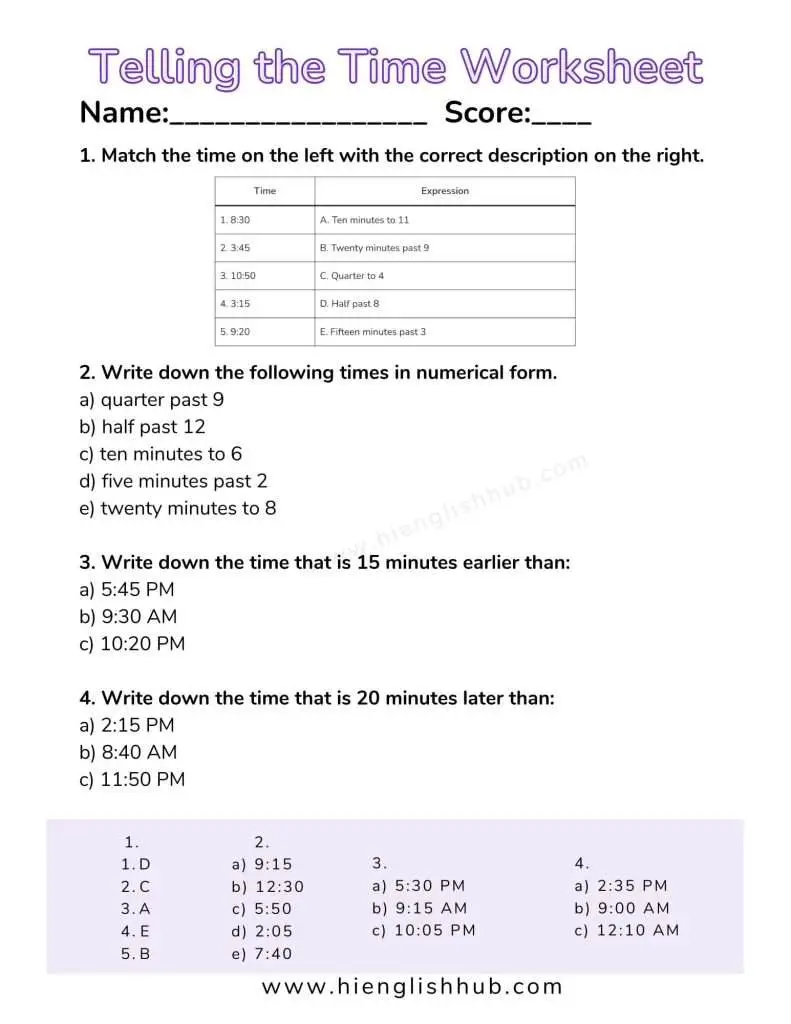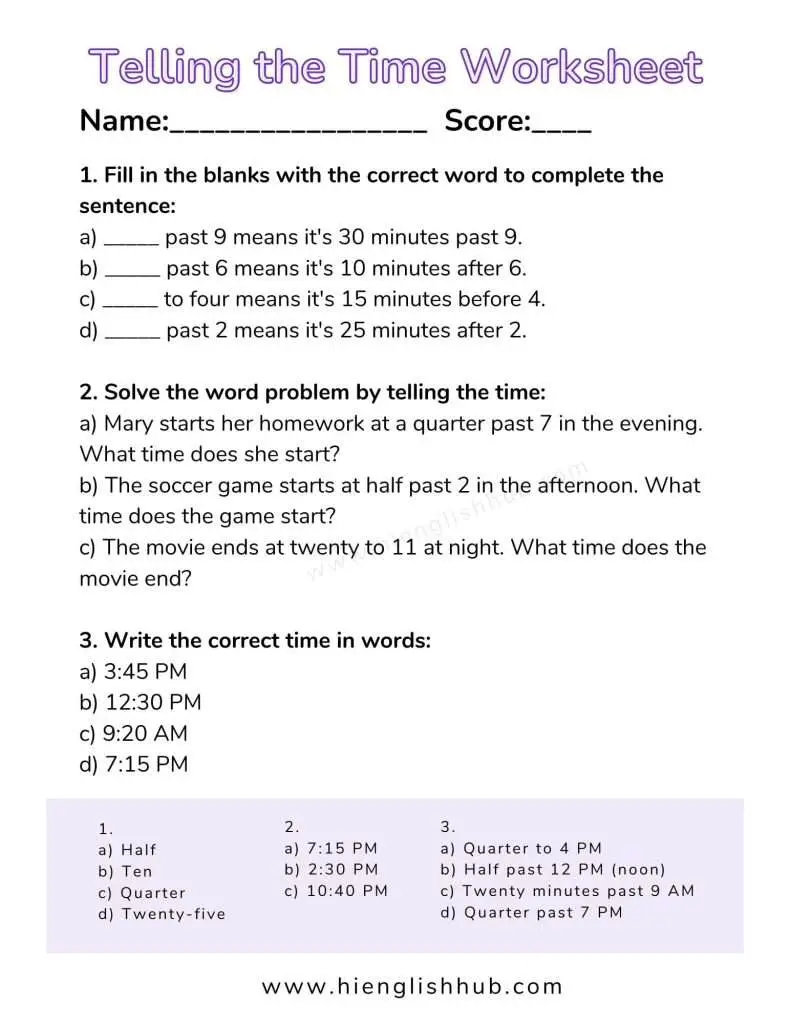Have you ever had trouble telling time in English?
Telling time is an important skill in any language, and it can be incredibly challenging for non-native speakers.
In this blog post, we will learn how to tell the time in English, and you will also find tips and tricks to help you improve your time-telling skills.
Importance Of Time in English
Telling time is an essential part of everyday life. It helps us plan our day and stay on schedule.
In English, time is also used in many common expressions and idioms, so understanding how to tell time is crucial for effective communication.
How To Ask For The Time In English
Asking for time is a common part of everyday conversation.
Below is a table with different ways to ask for time in English.
| How To Ask For The Time In English |
|---|
| What time is it? / What time is it right now? |
| Do you have the time? / Excuse me, do you have the time? |
| What time is the meeting/movie/etc.? |
| Have you got the time? |
| Do you know what time it is? |
| Do you happen to know what time it is? |
| Could you tell me the time, please? |
You can always use “please” to make your request more polite, and it’s important to be clear and polite when asking for the time.
If you’re unsure which phrase to use, “What time is it?” is always a safe bet.
With a bit of practice, telling time in English will become second nature to you!
How To Tell Time In English
Telling time is an essential life skill that you’ll use every day.
Whether you’re scheduling appointments, meeting up with friends, or catching a train, you need to know how to tell time accurately.
In English, we use a combination of numbers and words to express time.
We use the numbers on the clock to indicate the hour and the minutes.
We also use words like “past” and “to” to express the minutes after or before the hour.
Here’s a handy table that shows some common expressions for telling the time in English:
| Time Expression | Time |
|---|---|
| It’s half past three. / It’s thirty minutes past three. | 3:30 |
| It’s a quarter past four. / It’s fifteen minutes past four. | 4:15 |
| It’s twenty-five past seven. | 7:25 |
| It’s ten to two. | 1:50 |
| It’s five minutes to eight. | 7:55 |
| It’s noon. / It’s midday. | 12:00 PM |
| It’s midnight. | 12:00 AM |
| O’clock | Exact hour, e.g., “It’s 3 o’clock.” |
| Halfway/Half-past | 30 minutes past the hour, e.g., “It’s halfway/half-past 3 (3:30).” |
| A quarter past | 15 minutes past the hour, e.g., “It’s a quarter past 3 (3:15).” |
| A quarter to | 15 minutes before the next hour, e.g., “It’s a quarter to 4 (3:45).” |
| Five minutes past/to | 5 minutes past/to the hour, e.g., “It’s five minutes past/to 4 (4:05, 3.55).” |
| Ten minutes past/to | 10 minutes past/to the hour, e.g., “It’s ten minutes past/to 4 (4.10, 3:50).” |
| Twenty minutes past/to | 20 minutes past/to the hour, e.g., “It’s twenty minutes past/to 4 (4.20, 3:40).” |
What Are The Rules For Telling Time In English?
The rules for telling time in English are pretty straightforward.
Here are some key points to keep in mind:
- Exact hour: use “o’clock,” like 2 o’clock or 6 o’clock.
- 30 minutes past the hour: use “half past,” like half past 3 (3:30) or half past 11 (11:30).
- 15 minutes past the hour: use “quarter past,” like quarter past 8 (8:15) or quarter past 12 (12:15).
- 15 minutes before the next hour: use “quarter to,” like quarter to 5 (4:45) or quarter to 10 (9:45).
- Minutes after the hour, use “past.” For example, 9:10 or 4:20 can also be expressed as 10 minutes past 9 or 20 minutes past 4.
- Minutes before the next hour, use the word “to.” For instance, 6:35 or 10:50 would be 25 minutes to 7 or 10 minutes to 11, respectively.
- Remember to use “AM” for times before noon and “PM” for times after noon.
- Also, don’t forget to consider time zones if you’re talking to someone in a different region.
12-Hour Clock vs. 24-Hour Clock
The 12-hour clock is the one we’re all used to.
It has two sets of twelve numbers, with “AM” and “PM” to show whether it’s morning or evening.
So, for example, 8:00 AM is eight in the morning, and 8:00 PM is eight in the evening.
Simple, right?
But the 24-hour clock is a bit different.
Instead of two sets of twelve numbers, it uses one set of twenty-four numbers to show the time.
For instance, 8:00 AM is 08:00 in the 24-hour clock, and 8:00 PM is 20:00.
It might take a bit of getting used to, but it’s handy if you need to convert between different time zones or if you’re working with international colleagues.
In English, we use both the 12-hour clock and the 24-hour clock.
You might find the 12-hour clock used more often in everyday situations, like meeting up with friends, while the 24-hour clock is used more in formal or professional contexts.
Telling the Time Worksheets
Practice makes perfect, and worksheets are a great way to practice telling time in English.
Worksheet 1

1. Match the time on the left with the correct description on the right.
| Time | Expression |
|---|---|
| 1. 8:30 | A. Ten minutes to 11 |
| 2. 3:45 | B. Twenty minutes past 9 |
| 3. 10:50 | C. Quarter to 4 |
| 4. 3:15 | D. Half past 8 |
| 5. 9:20 | E. Fifteen minutes past 3 |
2. Write down the following times in numerical form.
a) quarter past 9
b) half past 12
c) ten minutes to 6
d) five minutes past 2
e) twenty minutes to 8
3. Write down the time that is 15 minutes earlier than:
a) 5:45 PM
b) 9:30 AM
c) 10:20 PM
4. Write down the time that is 20 minutes later than:
a) 2:15 PM
b) 8:40 AM
c) 11:50 PM
1.
- D
- C
- A
- E
- B
2.
a) 9:15
b) 12:30
c) 5:50
d) 2:05
e) 7:40
3.
a) 5:30 PM
b) 9:15 AM
c) 10:05 PM
4.
a) 2:35 PM
b) 9:00 AM
c) 12:10 AM
Worksheet 2

1. Fill in the blanks with the correct word to complete the sentence:
a) _____ past 9 means it’s 30 minutes past 9.
b) _____ past 6 means it’s 10 minutes after 6.
c) _____ to four means it’s 15 minutes before 4.
d) _____ past 2 means it’s 25 minutes after 2.
2. Solve the word problem by telling the time:
a) Mary starts her homework at a quarter past 7 in the evening. What time does she start?
b) The soccer game starts at half past 2 in the afternoon. What time does the game start?
c) The movie ends at twenty to 11 at night. What time does the movie end?
3. Write the correct time in words:
a) 3:45 PM
b) 12:30 PM
c) 9:20 AM
d) 7:15 PM
1.
a) Half
b) Ten
c) Quarter
d) Twenty-five
2.
a) 7:15 PM
b) 2:30 PM
c) 10:40 PM
3.
a) Quarter to 4 PM
b) Half past 12 PM (noon)
c) Twenty minutes past 9 AM
d) Quarter past 7 PM
Idioms and Expressions Related to Time in English
When it comes to time, the English language is full of interesting idioms and expressions.
Here are a few common ones that you might hear:
1. Time flies when you’re having fun
This means that time passes quickly.
Example: Wow, it’s already been an hour since we started studying! Time flies when you’re having fun.
2. In the nick of time
This means that something happened just in time to prevent a disaster.
Example: I finished my project in the nick of time. The deadline was just a few minutes away.
3. Time is money
This means that time is valuable and shouldn’t be wasted.
Example: I can’t stay here any longer, time is money, and I have a lot of work to do.
4. Killing time
This means passing the time and doing something unimportant or boring.
Example: I was just killing time at the airport, waiting for my flight.
5. A race against time
This means there is a limited amount of time to complete a task.
Example: We have to finish this project by tomorrow. It’s going to be a race against time.
6. Better late than never
Example: I know I’m late submitting my assignment, but better late than never, right?
7. Ahead of time
This means to be early or to do something earlier than expected.
Example: I finished my work ahead of time, so I could relax and enjoy my weekend.
8. Time heals all wounds
This means that over time, emotional or physical pain will eventually heal.
Example: Even though she was heartbroken when her boyfriend broke up with her, she knows that time heals all wounds.
FAQ
Here are the answers to frequently asked questions about telling time in English:
What Is The Easiest Way To Teach A Child To Tell The Time?
Teaching a child to tell the time can be challenging, but you can try some easy methods.
One effective way is to use an analog clock with large, clear numbers and hands.
You can also make a clock out of paper or use a digital clock with a visible second hand. Start by showing them the hour hand and teaching them how to count by fives.
Then, move on to the minute hand and show them how to count the minutes in each quarter of the hour.
Practicing regularly and using fun activities like games and quizzes can also make learning to tell time more enjoyable for kids.
How Do You Say 7:45 In English?
You can say “quarter to eight” or “seven forty-five” in English.
How do you say 3.30 AM in English?
You can say “three thirty in the morning” or “half past three in the morning.”
How do you say 3.45 PM in English?
You can say “three forty-five in the afternoon” or “quarter to four in the afternoon.”
How do you say 9.30 AM in English?
You can say “nine-thirty in the morning” or “half past nine in the morning.”
How do you say 6.45 AM in English?
You can say “six forty-five in the morning” or “quarter to seven in the morning.”
The Bottom Line
Telling time in English may seem daunting, but with practice and patience, anyone can master it.
I hope this blog post has provided you with the knowledge and resources to improve your time-telling skills in English.
Keep practicing, and soon you’ll be telling time like a native speaker!
If you enjoyed it, I would love it if you could share it with your friends and family on social media.
And if you want to stay up-to-date with my latest posts, be sure to follow me on Pinterest and Twitter.
Thanks again for reading, and I’ll catch you in the next post!

